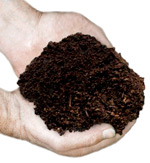Sustainable Gardening
Compost - Gardener's Gold

Compost bins come in all sizes and shapes. It may be a homemade wooden compost bin, a chickenwire cage or plastic barrel with holes.
Most homemade compost bins or designated spaces need to be constructed so that the pile can be about 4 feet square and a good 4 feet high to start with so the pile can heat up while it makes compost. As the Soil Food Web (including the microorganisms, fondly referred to as the Microherd) works and does its job, the pile will shrink.
As someone once wrote "'Compost Happens' It is the way the world runs, with the whole planet as a vast recycling machine."
In fact, ANY pile of organic matter will eventually rot down, whether it is a nicely-balanced mix of approximately equal bulk of "greens and "browns" in a nice bin, or a pile of odd weeds left in a corner, or even an old collection of twigs piled up somewhere.
What formal composting is supposed to achieve is a pile of good finished compost in as short a time as possible, usually 6-9 mo.
A Few Definitions:
The SOIL FOOD WEB - The community composed of varying organisms, from visible creatures like worms and pillbugs right down to microscopic bacteria and fungi (the Microherd), which between them convert the miscellaneous remains of vegetation into a fine earthy dark brown material known as humus.
FINISHED COMPOST is compost almost entirely converted to solace humus (some woody bits won't break down in one pass through a sieve and may remain). This is the material which will build up soil to a high state of fertility, contributing both to its texture and its food content. With enough humus in your soil and an initially good and complete kit of balanced minerals virtually NO other amendments (other than a layer of mulch on top) should be necessary to grow healthy plants and a nutritious edible crop.
Finished Compost has a dark brown color, sweet, earthy smell, and small fairly uniform particle size.
"GREENS" and "BROWNS" are the two essential groups of components for making good compost.
The "GREENS" comprise of all the nitrogen-rich plant remains, essentially the protein-rich tissues from the living parts of any sort of plant (including seaweeds). They may also include other N-rich materials from animal sources, such as manure (not from cats or dogs), hair or ground-up remains of fish (as fish meal). Waste woolen materials are another good source of nitrogen, such as discarded sweaters or old carpet (woolen, not synthetic of course!)
These organisms which rot down the organic matter to make successful compost must have access to PLENTY OF AIR and also supplies of BOTH CARBON and NITROGEN.
The carbon is used as a source of energyand the nitrogen to build up further
organisms while the air ensures only aerobic organisms which produce safe food
for plants can work in the material.
The "BROWNS" provide the energy food that the organisms need in order to break down the "greens." The browns are very high in carbon and include such things as wood and its variants, such as wood shreds, chips or sawdust, straw, fallen leaves, cotton waste (not synthetics though) and paper or cardboard.
These materials provide food for the organisms that are doing the breakdown and the process is in fact a continuous cycle of organisms feeding and dying and their bodies being fed on by other members of the Soil Food Web/Microherd until all the structures of the original materials have been broken down and the remains finally become humus.
Roughly equal parts of "greens and browns" are required to get the best balance for quick breakdown to occur. This process, unless hastened by forced draft (forcing sufficient oxygen into the mixture to ensure rapid decomposition) and other measures in commercial practice, usually takes around six months to a year to complete, depending on various factors such as the proportion of greens to browns, air, moisture, and ambient temperature and so on. Most gardeners find six months is about right for compost in the garden made over the summer, but a pile started just before winter, with no special protection from cold is not likely to be ready inside of nine months to a year.
Adding compost and mulch on top of the soil helps conserve water, reduces weeds and the need for pesticides – while also turning the soil into a living filter which removes pollutants from ground water and storm water runoff.

